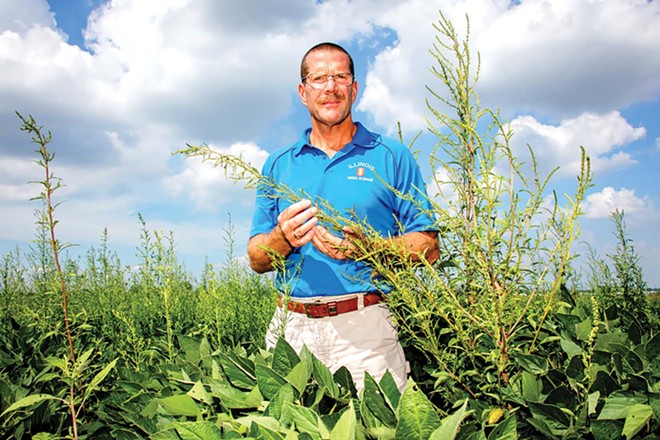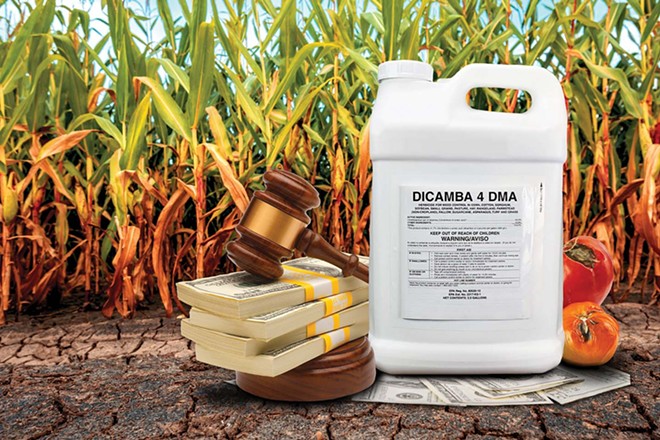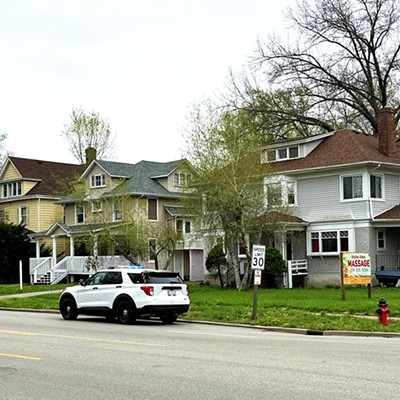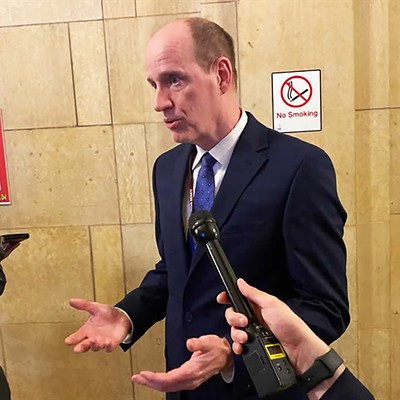As agricultural sagas go, controversy over an herbicide that's become ubiquitous in farm country would seem to have it all.
Millions, if not billions, of dollars are at stake. Without dicamba, an herbicide first sold while the Vietnam War raged, big agriculture says the nation's farmers would lose an important tool. Environmentalists warn that dicamba hasn't been proven safe even as it has become a go-to method for controlling weeds in soybean fields, and even as the herbicide damages non-targeted crops. While courtroom battles rage, farmers fret, uncertain about whether dicamba will be banned. Meanwhile, scientists wonder how long dicamba will keep killing weeds that tend to develop resistance to herbicides.
Dicamba works by mimicking auxin, a naturally occurring plant hormone that regulates plant growth. In desirable plants, agronomists use synthetic auxins to stimulate root development and promote growth. But synthetic auxins used as herbicides stimulate the over-production of ethelyne, another plant hormone, so that natural growth is impossible. Instead opening up and reaching for the sun, leaves cup and grow downward to the point that plants can die.
If that's all dicamba did, it might not be so controversial. The chemical has been used for decades, both in farmers' fields and in backyards – you can buy dicamba on Amazon. It kills dandelions and other broadleaf weeds, but not lawns, so it's used on golf courses and cemeteries, but at lower concentrations than on farms.
The problem is, dicamba doesn't always stay where it's sprayed. And that's proven a problem in farm country.
Risk well known
Invented during the 1950s, dicamba wasn't much noticed for decades, largely because of the way it was used.
The chemical's penchant for spreading from fields with weeds to fields with crops has long been known. During the early 1970s, University of Illinois researchers cautioned that dicamba can harm tomatoes, trees and junipers and so discouraged the chemical's use. "Fine spray particles may drift with the wind and carry the dicamba into soybeans," wrote Ellery Knake, a University of Illinois weed scientist, in a 1971 bulletin.
Applying dicamba on windy days wasn't the only worry.
Knake wrote that researchers had treated flats of corn with dicamba, which tolerates the chemical, then placed flats of untreated soybeans downwind from the corn. The soybeans soon showed signs of dicamba damage. "Apparently, vapor or very fine spray particles lingering in the air can move from a treated corn field on air currents some time after the application," Knake wrote. Adding thickening agents to herbicides containing dicamba or using special spray nozzles might help, Knake suggested. "Even so, this would not completely solve the problem of vapor movement," he wrote.
Nearly 50 years later, the same riddle remains.
Aaron Hager, a University of Illinois weed scientist, compares dicamba to water: If you leave a pan of water on an unlit stove for a few days, some will evaporate; turn the burner on and more will disappear. Dicamba is no different. The warmer the weather, the greater the evaporation rate. Unless evaporation, called volatility in the weed science world, is brought under control, Hager says that dicamba damage isn't a question of if, but of how much. And there has been plenty of damage in recent years.
"It's a total mindset"
With dicamba's dark side documented, generations of farmers used it sparingly, typically after harvest or in springtime, before soybeans sprouted. Corn farmers long have used dicamba early in growing seasons, usually before soybeans come up, but they avoid the chemical later in the year, Hager says, because it can make stalks brittle and susceptible to wind damage. Between 1993 and 1997, between 21% and 29% of U.S. corn acreage was treated with dicamba; by 2012, the figure had dropped to 12%.
For years, farmers had a better option than dicamba, thanks to John Franz, a Springfield native who concocted glyphosate, widely considered the planet's most successful herbicide, while working as a chemist for St. Louis-based Monsanto in 1970. Dubbed Roundup by Monsanto, glyphosate hit the market in 1974. Then Monsanto developed genetically engineered seeds that made crops immune to glyphosate, first introducing Roundup-resistant soybeans in 1996, followed by Roundup-resistant corn, followed by Roundup-resistant cotton and so on.
Roundup transformed large-scale farming. Properly applied, Roundup stayed put, killing weeds while Roundup-resistant crops thrived. In 1997, the year after Monsanto introduced Roundup-resistant soybeans, 17% of the nation's soybean crop came from herbicide-resistant seeds; by 2014, the figure stood at 90%, according to the U.S. Department of Agriculture, on par with the percentage of corn and cotton grown from seeds altered by scientists to resist herbicides.
It wasn't long before Roundup was no longer working as well as it once had.
Stephen Bowles, an Australian researcher, described the problem in a 2010 paper in which he wrote that glyphosate was as important to reliable food production as penicillin was for fighting disease. Just as bacteria develop resistance to antibiotics, weeds, Bowles wrote, were becoming immune to glyphosate, which farmers were over-using because it worked so well. And the more farmers sprayed Roundup, the worse the problem would become, he predicted. "Globally, no weed control tools are as good as glyphosate, and its potential widespread loss because of resistance is a looming threat to global cropping and food production," he wrote.
American farmers have been slow to heed Bowles' warning, according to Hager and Bob Hartzler, an Iowa State University weed scientist.

"Our entire cropping system is based on herbicidal weed control – nothing can control weeds as quickly as spraying a field," Hartzler says. "We have a generation of farmers where weed control is synonymous with herbicides. It's a total mindset. They've grown accustomed to, when one herbicide failed, industry provided another herbicide."
"We call them the Roundup babies – 'Why should we learn to do anything other than Roundup, because it works?'" says Hager, who recalls pulling weeds on his family's farm while growing up in Beardstown. "That sucked – that's why I'm doing this now."
A $265 million verdict
With Roundup losing effectiveness as weeds evolved, Monsanto began selling dicamba-resistant soybean seeds in 2016. But seeds were only half the equation.
Sales of dicamba-resistant soybean seeds began absent federal approval of an herbicide containing dicamba and glyphosate that Monsanto had developed for use with the new seeds. The new formula included so-called VaporGrip technology that would rein in dicamba's tendency to spread off fields, the company promised.
Long before dicamba-resistant soybeans came to market, Monsanto's scientists and executives discussed concerns. "The concept we are working with is that we will not only need to address these issues with the (regulatory) agencies, but also potentially in the courts," John Soteres, a Monsanto weed scientist, wrote in a 2010 email to colleagues asking for suggestions on how to argue for a product that would hit fields six years later. "In addition to, or instead of coexistence and resistance, we will be defending dicamba relative to drift and volatilization to nearby crops. As with resistance and coexistence, I am afraid that our defense will need to be centered around a strong stewardship program."
"One of the things we may want to consider is that just because the crop is dicamba tolerant does not mean a field needs to be sprayed with dicamba," suggested Russell Schneider, Monsanto's senior director for regulatory affairs and policy, in a reply email. "Maybe the first position could be that the use of dicamba will be as a rescue or spot spray treatment where resistant broadleaves have been observed."
Dicamba took off once Monsanto started selling resistant soybeans in 2016, absent the new herbicide that was supposed to keep the weedkiller in its place. Farmers who'd purchased dicamba-resistant soybeans used old formulations of dicamba on soybean fields with devastating effect, particularly in southern regions where weeds have proven tougher than in Illinois. Between 2012 and 2016, an average of 537,000 pounds of dicamba were used on American soybean fields each year. In 2017, after the EPA approved dicamba herbicides for soybeans during the growing season, nearly 8 million pounds of dicamba were sprayed on beanfields.
The new herbicides didn't work as billed, critics said. In Tennessee, a resort owner complained that dicamba had destroyed the garden where he had grown food to feed guests, and that the chemical was killing trees. "I have never seen an herbicide that has so easily and frequently slipped the leash," wrote Larry Steckel, a University of Tennessee weed scientist in a 2018 article published by Delta Farm Press. "Nor have I seen an herbicide that once off the leash would roam so far."
In 2017, a University of Missouri weed scientist estimated that 3.6 million acres of soybeans in 24 states, 4% of the nation's soybean acreage, was damaged by dicamba that had strayed from target fields, and a top EPA official said that estimate was conservative. That same year, the EPA, confronted with more than 2,700 complaints filed with state agriculture departments, acknowledged that dicamba damage was showing up in watermelons, cantaloupe, tobacco, pumpkins, vineyards and residential gardens. The agency also estimated that one in five dicamba damage incidents were officially reported.
A Missouri peach farmer sued Monsanto, which has since been acquired by Bayer, and BASF, a German chemical company that sells herbicides containing dicamba, over 2016 damage to his orchard. His lawyers introduced evidence suggesting profit motive: Monsanto had envisioned dicamba-resistant seed sales to farmers looking to guard against damage from neighboring fields. After a three-week trial in southern Missouri, a jury in February awarded a $265 million verdict, including $250 million in punitive damages, $50 million more than the plaintiff had suggested.
In the Missouri case, a Bayer lawyer sounded contrite after the blockbuster verdict. "We have the message," attorney Jan Paul Miller, once U.S. attorney in Springfield, told the St. Louis Post-Dispatch. "We did not do enough to protect farmers who do not deal with these kinds of (dicamba-resistant) crops."
In June, Bayer, separately from the peach orchard case, agreed to a $400 million settlement to resolve litigation filed by farmers over dicamba damage. The agreement came two weeks after the Ninth Circuit Court of Appeals ruled that the U.S. Environmental Protection Agency had wrongly greenlighted Monsanto's dicamba herbicide that the company had said would curb collateral damage.
The EPA, the court ruled, had underestimated risk and downplayed damage while approving a 40-page set of instructions that applicators said was hard, if not impossible, to follow: Apply only when the wind is between 3 mph and 10 mph and not blowing toward offsite crops; don't apply until one hour past sunrise and don't spray two hours before sunset; don't drive the tractor faster than 15 mph; make sure that spray booms aren't higher than two feet from the ground; don't apply if the forecast calls for rain or during temperature inversions when cool air is trapped near the ground; make sure there are buffers of trees or open space between fields; don't use if 45 days have passed since planting. Some states, including Illinois, have added tighter restrictions, including prohibiting dicamba application if the temperature is 85 degrees or higher.

If instructions are followed, applicators and weed scientists say, the legal window for spraying dicamba is narrow, and even then, unexpected weather can result in offsite damage from properly sprayed fields. Purdue University weed scientists calculated that if 2018 instructions had been in play the previous year, applying dicamba on soybeans would have been legal for 44 hours in June, a prime spraying month. In a 2018 survey of its membership, the Illinois Fertilizer and Chemical Association reported that 66% of respondents said they were able to effectively follow EPA-approved instructions, with an additional 28% answering "most of the time."
"This is the biggest challenge we have ever faced"
Dicamba use, and complaints, surged after the federal government approved dicamba herbicides for use during the growing season, as opposed to after harvest or before planting. The amount of dicamba sprayed on cotton and soybeans more than doubled between 2017, when 27 million acres of Monsanto's dicamba-resistant seeds were planted, and 2018, when dicamba was applied to 56 million acres, approximately half the U.S. acreage devoted to soybeans and cotton that year.
In Illinois, which led the nation in soybean production last year with more than 530 million bushels harvested from an area nearly as large as Massachusetts and Connecticut combined, the state Department of Agriculture logged 246 dicamba complaints in 2017, 330 in 2018 and 723 in 2019, with more than half of last year's complaints coming from six counties, including Champaign, Iroquois, Livingston, Ford, Vermillon and McLean. Fewer than five complaints were logged last year in Sangamon County. This year, the number of Illinois complaints dipped to 143, but that's not necessarily progress, considering that complaints about herbicide drift were rare before dicamba became common. Until a few years ago, Hager says, fewer than 10 dicamba complaints were logged annually.
Jean Payne, president of the Illinois Fertilizer and Chemical Association, agrees with Hager: This year isn't a success story, given the paucity of complaints before dicamba took hold in soybean country.
"Less than 100 people would pick up the phone and file a complaint with the Department of Agriculture," Payne says. "To go from 100 complaints to 300 to 500 to 700 has been extremely concerning. ... This is the biggest challenge we have ever faced, in my opinion."
Payne blames rain, or lack thereof, for the explosion of complaints in 2019. While applicators shouldn't spray if rain is predicted in the next 24 hours, dicamba can volatilize and spread during prolonged dry weather, especially if it's hot, and July in 2019 was warm and dry, she says. Rain, Payne says, also helps non-resistant plants shake off dicamba effects, and rainfall this summer arrived in timely fashion, likely staving off complaints from farmers whose crops showed damage signs but recovered.
This year, Iowa was hammered, with more than 700 complaints filed and agronomists reporting that nearly all soybeans not resistant to dicamba showed signs of damage. "This is not the type of injury we have observed in the past; it's at landscape level," wrote Hartzler in a July article published by Iowa State University.
There are several explanations. Maybe it was the weather, with winds or high temperatures causing dicamba to spread so widely from multiple fields that pinpointing a source can prove impossible – weed scientists call it "atmospheric loading." A lack of rain may also have played a role. Maybe it was farmers, who have reputations for not embracing regulators, finally complaining after years of damage and no progress in sight, or perhaps farmers continued using old-school dicamba herbicides instead of new formulations that are supposed to cause less damage. Maybe, Hartzler suggests, the appellate court in California played a role.
The court's June 3 ruling that threw out federal approval of dicamba herbicides upended the soybean world on the cusp of dicamba-spraying season. Farmers buy seed in autumn, and so soybean growers who'd purchased dicamba-resistant seed were faced with the prospect of not being able to apply their herbicide of choice. That may have encouraged some farmers to go ahead with dicamba, Hartzler figures, even if the weather wasn't right.
Despite the court ruling, dicamba was allowed this growing season, with the EPA deciding that existing stocks could be used and the court rejecting a plaintiff's request for an immediate ban. In Illinois, the Department of Agriculture banned the sale and use of dicamba after the June ruling, then reversed course in less than a week. But the issue is far from settled.
The federal EPA now must decide whether dicamba will be allowed next year and, if so, under what conditions, which could mean changes to an instruction book the appellate court has already criticized. A decision is expected in late October.
"Somehow, the U.S. EPA has to figure out what they're going to change on this (instruction) label to allow growers to use it but also satisfy the Ninth Circuit," Payne says. "I don't know what the middle of the line is going to be, but a lot of people have a lot of apprehension about it. ... We have urged U.S. EPA to make some kind of decision, no matter what it is, as soon as possible."
Even if dicamba use continues, Payne agrees with weed scientists: It will work only until weeds adapt, and scientists in Tennessee and other states already have found such pests as pigweed, which can destroy entire soybean fields, have developed dicamba immunity. "In the next five to eight years, there's nothing new coming," Payne says.
Why should anyone outside pigweed country care? Dicamba, after all, has not been shown to pose a hazard to humans, and there's no proof that animals suffer.
Payne says it's a matter of trust. "I think you care because, overall, anytime the word 'pesticide' is used, it's very important to everyone that these products work the way they're intended to work," she says.
Hager and Hartzler, who says he saw damage on trees in northern Iowa this summer, wonder about the long-term health of sycamores, oaks and other trees. "We're not killing trees, but if we ding them up every year, that's not good for them," Hartzler says. "My concern is, is a regulatory agency doing its job? ... In the past I trusted the EPA to make sure pesticides were safe. In this case, I feel qualified to say they have failed. If they've failed here, what other decisions have they failed on?"
Jim Goodman, president of the National Coalition of Family Farms that sued to overturn EPA approval of dicamba, says it's a matter of basic fairness. No one, the retired dairy farmer says, should have the right to use any chemical that spreads uninvited onto neighboring land.
Farmers, perhaps like weeds, may have to adapt. The days of relying on herbicides alone to control weeds are nearing an end, weed scientists say, and farmers who don't plant cover crops in the autumn, which help control weeds in the spring, or take steps to keep weed seeds out of fields, instead of allowing them to scatter at harvest, are at risk. Even walking fields to pull weeds before they gain solid footholds can help in some cases, Hager says.
"We're at the point where we can still limp along with herbicides, but whether that will last five years or 10 years, I don't know," Hartzler says. "We're still in a period of denial. That's going to change, I think, in the near future."
Contact Bruce Rushton at [email protected].





















